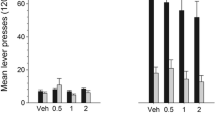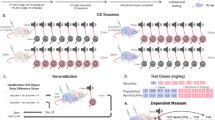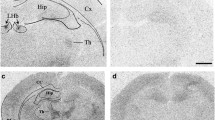Abstract
Dopamine D3 receptors (Drd3) have been implicated in the control of responding by drug-related conditioned incentive stimuli. We review recent studies of the effects of Drd3 antagonists or partial agonists on the control of self-administration of intravenous (IV) cocaine, IV morphine and oral ethanol on reward-rich and lean schedules, in reinstatement tests, on second-order schedules and on the acquisition and expression of conditioned place preference (CPP) and conditioned motor activity. For comparison, related studies where conditioned stimuli are based on nutritional reward also are considered. When self-administration depends more heavily on conditioned cues for its maintenance, for example on second-order schedules or lean ratio schedules, Drd3 antagonists or partial agonists reduce responding. Although data are limited, similar effects may be seen for responding for cues based on drugs or nutritional rewards. Drd3 agents also block the ability of conditioned cues to reinstate responding for cocaine or food. Published results suggest that Drd3 plays a more important role in the expression than in the acquisition of a CPP or conditioned motor activity. The mechanism mediating the role of Drd3 in the control of responding by conditioned incentive stimuli remains unknown but it has been found that Drd3 receptors increase in number in the nucleus accumbens during conditioning. Perhaps Drd3 participates in the molecular mechanisms underlying the role of dopamine and of dopamine receptor subtypes in reward-related incentive learning.
Similar content being viewed by others
References
Arroyo M, A Markou and TW Robbins (1998) Acquisition, maintenance and reinstatement of intravenous cocaine self-administration under a second-order schedule of reinforcement in rats: effects of conditioned cues and unlimited access to cocaine.Psychopharmacology 140, 331–344.
Ashby CR Jr, M Paul, EL Gardner, CA Heidbreder and JJ Hagan (2003) Acute administration of the selective D3 receptor antagonist SB-277011A blocks the acquisition and expression of the conditioned place preference response to heroin in male rats.Synapse 48(3), 154–156.
Aujla H and RJ Beninger (2004) Intra-BLA or intra-NAc infusions of the dopamine D3 receptor partial agonist, BP 897, block intra-NAc amphetamine conditioned activity.Behav. Neurosci. 118, 1324–1330.
Aujla H and RJ Beninger (2005) The dopamine D3 receptor-preferring partial agonist BP 897 dose-dependently attenuates the expression of amphetamine-conditioned place preference in rats.Behav. Pharmacol. 16, 181–186.
Aujla H, P Sokoloff and RJ Beninger (2002) A dopamine D3 receptor partial agonist blocks the expression of conditioned activity.NeuroReport 13, 173–176.
Banasikowski TJ, A Bespalov, K Drescher and RJ Beninger (2007) Double dissociation of the effects of haloperidol and the dopamine receptor-specific antagonist ABT-127 on acquisition and expression of conditioned activity. Program No. 843.6/WW19. 2007 Neuroscience Meeting Planner. San Diego CA: Society for Neuroscience. Online.
Beninger RJ (1983) The role of dopamine in locomotor activity and learning.Brain Res. 287, 173–196.
Beninger RJ and TV Gerdjikov (2004) The role of signaling molecules in reward-related incentive learning.Neurotox. Res. 6, 91–104.
Beninger RJ and TV Gerdjikov (2005) Dopamine-glutamate interactions in reward-related incentive learning, In:Dopamine and Glutamate in Psychiatric Disorders (Schmidt WJ and ME Reith, Eds.) (Humana Press Inc:Totawa, NJ, USA), pp 319–354.
Beninger RJ and R Miller (1998) Dopamine D1-like receptors and reward-related incentive learning.Neurosci. Biobehav. Rev. 22, 335–345.
Beninger RJ, DC Hoffman and EJ Mazurski (1989) Receptor subtype-specific dopaminergic agents and conditioned behavior.Neurosci. Biobehav. Rev. 13, 113–122.
Berridge KC and TE Robinson (1998) What is the role of dopamine in reward: hedonic impact, reward learning, or incentive salience?Brain Res. Rev. 28, 309–369.
Bezard E, S Ferry, U Mach, H Stark, L Leriche, T Boraud, C Gross and P Sokoloff (2003) Attenuation of levodopa-induced dyskinesia by normalizing dopamine D3 receptor function.Nat. Med. 9, 762–767.
Bindra D (1978) How adaptive behavior is produced: a perceptualmotivational alternative to response-reinforcement.Behav. Brain Sci. 1, 41–91.
Bolles RC (1972) Reinforcement, expectancy, and learning.Psychol. Rev. 79, 394–407.
Cervo L and R Samanin (1995) Effects of dopaminergic and glutamatergic receptor antagonists on the acquisition and expression of cocaine conditioning place preference.Brain Res. 673, 242–250.
Cervo L, F Carnovali, JA Stark and T Mennini (2003) Cocaineseeking behavior in response to drug-associated stimuli in rats: involvement of D3 and D2 dopamine receptors.Neuropsychopharmacology 28, 1150–1159.
Cervo L, S Burbassi, M Colovic and S Caccia (2005) Selective antagonist at D3 receptors, but not non-selective partial agonists, influences the expression of cocaine-induced conditioned place preference in free-feeding rats.Pharmacol. Biochem. Behav. 82, 727–734.
Cervo L, A Cocco, C Petrella and CA Heidbreder (2007) Selective antagonism at dopamine D3 receptors attenuates cocaine-seeking behaviour in the rat.Int. J. Neuropsycho-pharmacol. 10, 167–181.
Claytor R, JA Lile and MA Nader (2006) The effects of eticlopride and the selective D3-antagonist PNU 99194-A on food- and cocaine-maintained responding in rhesus monkeys.Pharmacol. Biochem. Behav. 83, 456–464.
Davis WM and SG Smith (1979) Role of conditioned reinforcers in the institution, maintenance and extinction of drug seeking behaviour.Pavlov. J. Biol. Sci. 11, 222–236.
de Wit H and J Stewart (1981) Reinstatement of cocaine-reinforced responding in the rat.Psychopharmacology (Berl.) 75, 134–143.
Di Chiara G (1999) Drug addiction as dopamine-dependent associative learning disorder.Eur. J. Pharmacol. 375, 13–30.
Di Ciano P (2008) Drug seeking under a second-order schedule of reinforcement depends on dopamine D3 receptors in the basolateral amygdala.Behav. Neurosci. 122, 129–139.
Di Ciano P, RJ Underwood, JJ Hagan and BJ Everitt (2003) Attenuation of cue-controlled cocaine-seeking by a selective D3 dopamine receptor antagonist SB-277011-A.Neuropsychopharmacology 28, 329–338.
Drescher K, B Behl, AS Freeman, ME Hamilton, KM Wicke, LV Unger, A Haupt, G Gross, H Schoemaker and JP Sullivan (2005) ABT-127, a new selective dopamine D3 receptor antagonist: neurochemical and electrophysiological studiesin vivo. Program No. 913.19. 2005 Abstract Viewer/Itinerary Planner. Washington, DC: Society for Neuroscience. Online.
Duarte C, C Lefebvre, F Chaperon, M Hamon and MH Thiebot (2003) Effects of a dopamine D3 receptor ligand, BP 897, on acquisition and expression of food-, morphine-, and cocaineinduced conditioned place preference, and food-seeking behavior in rats.Neuropsychopharmacology 28, 1903–1915.
Fontana DJ, RM Post and A Pert (1993) Conditioned increases in mesolimbic dopamine overflow by stimuli associated with cocaine.Brain Res. 629, 31–39.
Frances H, B Le Foll, J Diaz, M Smirnova and P Sokoloff (2004) Role of drd3 in morphine-induced conditioned place preference using drd3-knockout mice.NeuroReport 15, 2245–2249.
Gàl K and I Gyertyàn (2003) Targeting the dopamine D3 receptor cannot influence continuous reinforcement cocaine self-administration in rats.Brain Res. Bull. 61, 595.
Gàl K and I Gyertyàn (2006) Dopamine D3 as well as D2 receptor ligands attenuate the cue-induced cocaine-seeking in a relapse model in rats.Drug Alcohol Depend. 81, 63–70.
Gilbert JG, AH Newman, EL Gardner, CR Ashby Jr, CA Heidbreder, AC Pak, XQ Peng and ZX Xi (2005) Acute administration of SB-277011A, NGB 2904, or BP 897 inhibits cocaine cue-induced reinstatement of drug-seeking behavior in rats: role of dopamine D3 receptors.Synapse 57, 17–28.
Goldberg SR (1973) Comparable behavior maintained under fixed-ratio and second-order schedules of food presentation, cocaine injection or D-amphetamine injection in the squirrel monkey.J. Pharmacol. Exp. Ther. 186, 18–30.
Gross G, KU Drescher, A. Haupt, H-J Teschendorf, A Jongen-Relo, KM Wicke, M Zhang, KE Brownman, ME Ballard, LE Rueter, MW Decker, H Schoemaker and JP Sullivan (2005) ABT-127, a new selective dopamine D3 receptor antagonist: behavioral pharmacology studies. Program No. 913.20. 2005 Abstract Viewer/Itinerary Planner. Washington, DC: Society for Neuroscience. Online.
Gyertyàn I and K Gàl (2003) Dopamine D3 receptor ligands show place conditioning effect but do not influence cocaine-induced place preference.NeuroReport 14, 93–98.
Gyertyan I, B Kiss, K Gal, I Laszlovszky, A Horvath, LI Gemesi, K Saghy, G Pasztor, M Zajer, M Kapas, EA Csongor, G Domany, K Tihanyi and Z Szombathelyi (2007) Effects of RGH-237 [N-4-[4-(3-aminocarbonyl-phenyl)-piperazin-1-yl]-butyl-4-bromo-benzamide], an orally active, selective dopamine D3 receptor partial agonist in animal models of cocaine abuse.J. Pharmacol. Exp. Ther. 320, 1268–1278.
Heidbreder CA, EL Gardner, ZX Xi, PK Thanos, M Mugnaini, J Jagan and CR Ashby Jr (2005) The role of central dopamine D3 receptors in drug addiction: a review of pharmacological evidence.Brain Res. Rev. 49, 77–105.
Heidbreder CA, M Andreoli, C Marcon, DM Hutcheson, EL Gardner and CR Ashby Jr (2007) Evidence for the role of dopamine D3 receptors in oral operant alcohol self-administration and reinstatement of alcohol-seeking behavior in mice.Addict. Biol. 12, 35–50.
Ito R, JW Dalley, SR Howes, TW Robbins and BJ Everitt (2000) Dissociation in conditioned dopamine release in the nucleus accumbens core and shell in response to cocaine cues and during cocaine-seeking behavior in rats.J. Neurosci. 20, 7489–7495.
Kelleher RT (1966) Chaining and conditioned reinforcement, In:Operant Behavior: Areas of Research and Application (Honig WK, Ed.) (Prentice-Hall:Englewood Cliffs, NJ, USA), pp 160–212.
Kiyatkin EA and EA Stein (1996) Conditioned changes in nucleus accumbens dopamine signal established by intravenous cocaine in rats.Neurosci. Lett. 211, 73–76.
Le Foll B, H Frances, J Diaz, JC Schwartz and P Sokoloff (2002) Role of the dopamine D3 receptor in reactivity to cocaineassociated cues in mice.Eur. J. Neurosci. 15, 2016–2026.
Le Foll B, P Sokoloff, H Stark and SR Goldberg (2005) Dopamine D3 receptor ligands block nicotine-induced conditioned place preferences through a mechanism that does not involve discriminative-stimulus or antidepressant-like effects.Neuropsychopharmacology 30, 720–730.
Levant B (1997) The D3 dopamine receptor: neurobiology and potential clinical relevance.Pharmacol. Rev. 49, 231–252.
Mach UR, AE Hackling, S Perachon, S Ferry, CG Wermuth, JC Schwartz, P Sokoloff and H Stark (2004) Development of novel 1,2,3,4-tetrahydroisoquinoline derivatives and closely related compounds as potent and selective dopamine D3 receptor ligands.Chembiochem. 5, 508–518.
Mackintosh NJ (1974)The Psychology of Animal Learning (Academic Press:London).
Martelle JL, R Claytor, JT Ross, BA Reboussin, AH Newman and MA Nader (2007) Effects of two novel D3-selective compounds, NGB 2904 [N-(4-(4-(2,3-dichlorophenyl)piperazin-1-yl)butyl)-9H-fluorene-2-carboxami de] and CJB 090 [N-(4-(4-(2,3-dichlorophenyl)piperazin-1-yl)butyl)-4-(pyridin-2-yl)ben-zami de], on the reinforcing and discriminative stimulus effects of cocaine in rhesus monkeys.J. Pharmacol. Exp. Ther. 321, 573–582.
Miller R (1981)Meaning and Purpose in the Intact Brain (Clarendon Press:Oxford).
Miller R (2008)A Theory of the Basal Ganglia and Their Disorders (CRC Press:Boca Raton).
Miller R, JR Wickens and RJ Beninger (1990) Dopamine D-1 and D-2 receptors in relation to reward and performance: a case for the D-1 receptor as a primary site of therapeutic action of neuroleptic drugs.Prog. Neurobiol. 34, 143–183.
Morency MA and RJ Beninger (1986) Dopaminergic substrates of cocaine-induced place conditioning.Brain Res. 399, 33–41.
Neisewander JL, RA Fuchs, LTL Tran-Nguyen, SM Weber, GP Coffey and JN Joyce (2004) Increases in dopamine D3 receptor binding in rats receiving a cocaine challenge at various time points after cocaine self-administration: implications for cocaine-seeking behavior.Neuropsychopharmacology 29, 1479–1487.
Pak AC, CR Ashby Jr, CA Heidbreder, M Pilla, J Gilbert, ZX Xi and EL Gardner (2006) The selective dopamine D3 receptor antagonist SB-277011Areduces nicotine-enhanced brain reward and nicotine-paired environmental cue functions.Int. J. Neuropsychopharmacol. 9, 585–602.
Pickens RW and WF Crowder (1967) Effects of CS-US interval on conditioning of drug response, with assessment of speed of conditioning.Psychopharmacologia 11, 88–94.
Pilla M, S Perachon, F Sautel, F Garrido, A Mann, CG Wermuth, JC Schwartz, BJ Everitt and P Sokoloff (1999) Selective inhibition of cocaine-seeking behaviour by a partial dopamine D3 receptor agonist.Nature 400, 371–375.
Reynolds GS (1968)A Primer of Operant Conditioning (Scott, Foresman:Glenview IL).
Robbins TW and BJ Everitt (1996) Neurobehavioural mechanisms of reward and motivation.Curr. Opin. Neurobiol. 6, 228–236.
Roberts DCS and N Goeders (1989) Drug self-administration experimental methods and determinants, In:Neuromethods 13:Psychopharmacology (Boulton AA, GB Baker and AJ Greenshaw, Eds.) (Humana Press:Clifton NJ, USA), pp 349–398.
Ross JT, WA Corrigall, CA Heidbreder and MG LeSage (2007) Effects of the selective dopamine D3 receptor antagonist SB-277011A on the reinforcing effects of nicotine as measured by a progressive-ratio schedule in rats.Eur. J. Pharmacol. 559, 173–179.
Schultz W, P Dayan and PR Montague (1997) A neural substrate of prediction and reward.Science 275, 1593–1599.
Spyraki C, HC Fibiger and AG Phillips (1982) Attenuation by haloperidol of place preference conditioning using food reinforcement.Psychopharmacology (Berl.) 77, 379–382.
Stoof JC and JW Kebabian (1981) Opposing roles for D-1 and D-2 dopamine receptors in efflux of cyclic AMP from rat neostriatum.Nature 294, 366–368.
Thanos PK, JM Katana, CR Ashby Jr, M Michaelides, EL Gardner, CA Heidbreder and ND Volkow (2005) The selective dopamine D3 receptor antagonist SB-277011-A attenuates ethanol consumption in ethanol preferring (P) and non-preferring (NP) rats.Pharmacol. Biochem. Behav. 81, 190–197.
Thanos PK, M Michaelides, CW Ho, GJ Wang, AH Newman, CA Heidbreder, CR Ashby Jr, EL Gardner and ND Volkow (2008) The effects of two highly selective dopamine D3 receptor antagonists (SB-277011A and NGB-2904) on food self-administration in a rodent model of obesity.Pharmacol. Biochem. Behav. 89, 499–507.
Tzschentke TM (1998) Measuring reward with the conditioned place preference paradigm: a comprehensive review of drug effects, recent progress and new issues.Prog. Neurobiol. 56, 613–672.
Unger LV, W Wernet, R Mueller, FJ Garcia-Ladona, R Moreland, A Haupt, A Hahn, H Schoemaker and JP Sullivan (2005) Abt-127, a new selective dopamine D3 receptor antagonist: binding and functional propertiesin vitro. Program No. 913.18. 2005.Abstract Viewer/Itinerary Planner. Washington, DC: Society for Neuroscience. Online.
Vallone D, Picetti R and Borrelli E (2000) Structure and function of dopamine receptors.Neurosci. Biobehav. Rev. 24, 125–132.
van der Kooy (1987) Place conditioning: a simple ands effective method for assessing the motivational properties of drugs, In:Methods of Assessing the Reinforcing Properties of Abused Drugs (Bozarth MA, Ed.) (Springer Verlag:New York), pp 229–240.
]Vazquez V, S Weiss, B Giros, MP Martres and V Dauge (2007) Maternal deprivation and handling modify the effect of the dopamine D3 receptor agonist, BP 897 on morphine-conditioned place preference in rats.Psychopharmacology (Berl.) 193, 475–486.
Vengeliene V, F Leonardi-Essmann, S Perreau-Lenz, P Gebicke-Haerter, K Drescher, G Gross and R Spanagel (2006) The dopamine D3 receptor plays an essential role in alcohol-seeking and relapse.FASEBJ. 20, 2223–2233.
Vorel SR, CR Ashby Jr, M Paul, X Liu, R Hayes, JJ Hagan, DN Middlemiss, G Stemp and EL Gardner (2002) Dopamine D3 receptor antagonism inhibits cocaine-seeking and cocaineenhanced brain reward in rats.J. Neurosci. 22, 9595–9603.
Whitelaw RB, A Markou, TW Robbins and BJ Everitt (1996) Excitotoxic lesions of the basolateral amygsala impair the acquisition of cocaine-seeking behaviour under a second-order schedule of reinforcement.Psychopharmacology 127, 213–224.
Wise RA, J Spindler, H de Wit and GJ Gerber (1978) Neurolepticinduced “anhedonia” in rats: pimozide blocks reward quality of food.Science 201, 262–264.
Xi ZX and EL Gardner (2007) Pharmacological actions of NGB 2904, a selective dopamine D3 receptor antagonist, in animal models of drug addiction.CNS Drug Rev. 13, 240–259.
Xi ZX, JG Gilbert, AC Pak, CR Ashby Jr., CA Heidbreder and EL Gardner (2005) Selective dopamine D3 receptor antagonism by SB-277011A attenuates cocaine reinforcement as assessed by progressive-ratio and variable-cost-variable-payoff fixed-ratio cocaine self-administration in rats.Eur. J. Neurosci. 21, 3427–3438.
Xi ZX, AH Newman, JG Gilbert, AC Pak, XQ Peng, CR Ashby Jr, L Gitajn and EL Gardner (2006) The novel dopamine D3 receptor antagonist NGB 2904 inhibits cocaine’s rewarding effects and cocaine-induced reinstatement of drug-seeking behavior in rats.Neuropsychopharm-acology 31, 1393–1405.
Author information
Authors and Affiliations
Corresponding author
Rights and permissions
About this article
Cite this article
Beninger, R.J., Banasikowski, T.J. Dopaminergic mechanism of reward-related incentive learning: Focus on the dopamine d3 receptor. neurotox res 14, 57–69 (2008). https://doi.org/10.1007/BF03033575
Received:
Revised:
Issue Date:
DOI: https://doi.org/10.1007/BF03033575




